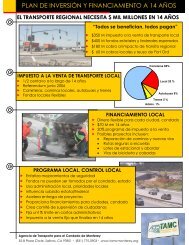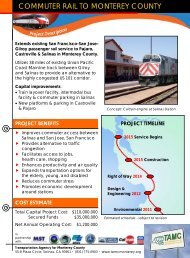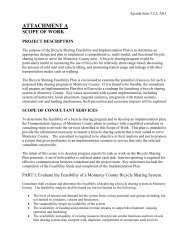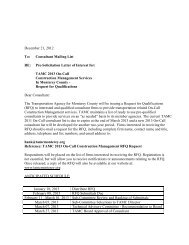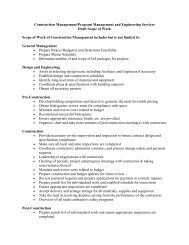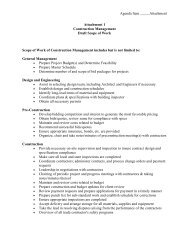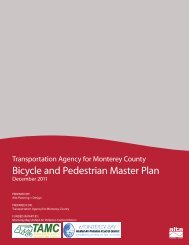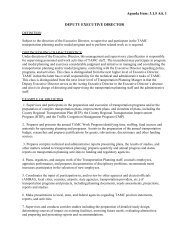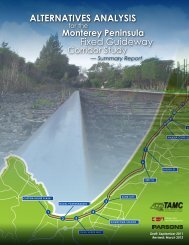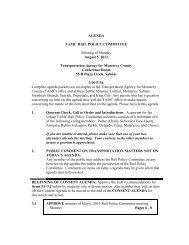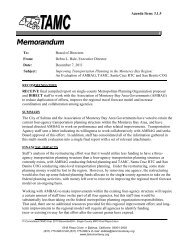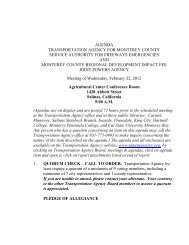156 Toll Road Study and Appendices - Transportation Agency for ...
156 Toll Road Study and Appendices - Transportation Agency for ...
156 Toll Road Study and Appendices - Transportation Agency for ...
- No tags were found...
You also want an ePaper? Increase the reach of your titles
YUMPU automatically turns print PDFs into web optimized ePapers that Google loves.
<strong>Toll</strong>ing Traffic <strong>and</strong> Revenue <strong>Study</strong> Highway <strong>156</strong> CorridorTraffic <strong>and</strong> Revenue AnalysisTRAVEL TIME SAVINGS DUE TO HIGHWAY <strong>156</strong> IMPROVEMENTSTo determine how traffic will respond to paying a toll to travel on improved Highway <strong>156</strong>,alternative routes going from the same origin <strong>and</strong> destination as Highway <strong>156</strong> must beidentified. A relationship between the travel time savings <strong>for</strong> motorist choosing to travel onHighway <strong>156</strong>, opposed to other alternative routes, <strong>and</strong> the cost of paying a toll wasinvestigated.Traveler Value-of-TimeA key parameter, when evaluating potential diversion due to toll, is the value of travel timesavings, or value of time associated with any given traveler. The value of time is defined as auser’s willingness to pay to avoid delay, measured in dollars per hour. The value of time is afunction of several factors such as trip purpose (type), length of the trip, available alternativeroutes, total time savings, reliability, congestion, traveler income levels, time of day <strong>and</strong>other factors such as location of the toll road. Research shows that value of time is closelyrelated to income levels or average wage rates. Values-of-time used in this study rely on theaverage wage rates of workers inside <strong>and</strong> outside the study area, as well as trip purpose.There is a substantial body of research showing that these relationships are relativelyconstant across geographies, particularly when corrected <strong>for</strong> local wage variations <strong>and</strong> costof living. Research also shows that the value of time varies by income levels, trip purpose<strong>and</strong> the trip distance. Value of time <strong>for</strong> truck purpose does not change as a function ofdistance. Among others, the USDOT has issued guidance on valuing travel time with such arecommendation. Estimates <strong>for</strong> values of time <strong>for</strong> passenger cars were based on theserecommendations <strong>and</strong> available wage data.This study derived values-of-time <strong>for</strong> travelers’ based on wage rates compiled from theAmerican Community Survey <strong>for</strong> Monterey, San Benito, Santa Cruz <strong>and</strong> Santa Claracounties. Specifically the valuation of time savings as a function wage rates was conductedin accordance with USDOT’s “Departmental Guidance <strong>for</strong> the Valuation of Travel Time inEconomic Analysis”, originally issued in 1997 <strong>and</strong> updated in 2003. Table 4: TravelerValues-of-Time Savings includes values-of-time (2012 US dollars) used in this study <strong>for</strong> eachof the previously identified market segments.9



